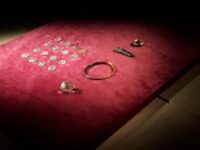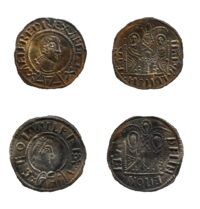 George Powell and Layton Davies, the metal detecting looters who stole the Herefordshire Viking hoard, will have to pay through the nose for their greed. Convicted of theft and concealment in 2019, Powell and Davies were sentenced to long prison terms (10 years and 8.5 years respectively). Now a judge has ordered them to cough up more than £600,000 apiece within three months or an additional five years will be added to their sentences.
George Powell and Layton Davies, the metal detecting looters who stole the Herefordshire Viking hoard, will have to pay through the nose for their greed. Convicted of theft and concealment in 2019, Powell and Davies were sentenced to long prison terms (10 years and 8.5 years respectively). Now a judge has ordered them to cough up more than £600,000 apiece within three months or an additional five years will be added to their sentences.
The hoard of Anglo-Saxon coins, jewelry and silver ingots, buried in the late 9th century, was discovered in 2015 in a field in Eye, near Leominster, Herefordshire, on private property which Powell and Davies did not have permission to scan. They hid the find and made arrangements to sell this archaeological treasure  on the black market. By the time authorities became aware of it (thanks to these clowns posting a picture on a metal detecting website of the hoard in situ), most of the coins and all but one ingot were scattered to the four winds. Only 29 of the estimated 300 coins were recovered, a tragic loss considering that the few remaining coins contain extremely rare “Two-Emperor” pennies commemorating an alliance between Alfred the Great of Wessex and Ceolwulf II of Mercia.
on the black market. By the time authorities became aware of it (thanks to these clowns posting a picture on a metal detecting website of the hoard in situ), most of the coins and all but one ingot were scattered to the four winds. Only 29 of the estimated 300 coins were recovered, a tragic loss considering that the few remaining coins contain extremely rare “Two-Emperor” pennies commemorating an alliance between Alfred the Great of Wessex and Ceolwulf II of Mercia.
Coin dealer Simon Wicks who fenced some of their loot was also convicted of concealment and sentenced to five years in jail. Judge Nicholas Cartwright believes the that Powell and Davies are still holding out on the authorities, that they are still hiding the 270 missing coins or that they at least know where they are. That’s why he’s hitting them in the only place they care about: their wallets.
When the men were sentenced, the judge said that if they had obtained the correct permission they would have gone on to receive up to half the £3m value of the hoard between them.
He said he rejected their accounts that the items were with other people and an auction house in Austria and said the men deliberately stole items.
“They acted together dishonestly. They jointly stole the items and jointly intended to split and sell the bracelet,” Judge Cartwright said.
![]() The 29 coins, one silver ingot, a gold arm bangle with a clasp in the shape of a beast head, a rock crystal sphere encased in an ornately decorated openwork gold frame-like cage believed to be of Frankish manufacture and a gold octagonal ring with black niello inlay are what remains of the hoard at this time. The group is currently on display at Hereford’s Museum Resource and Learning Centre and thanks to a successful fundraising campaign, it will stay in Herefordshire. Funds have been allocated to redevelop the Hereford Museum and Art Gallery (HMAG) into a state-of-the-art cultural destination and the Viking hoard will be its centerpiece.
The 29 coins, one silver ingot, a gold arm bangle with a clasp in the shape of a beast head, a rock crystal sphere encased in an ornately decorated openwork gold frame-like cage believed to be of Frankish manufacture and a gold octagonal ring with black niello inlay are what remains of the hoard at this time. The group is currently on display at Hereford’s Museum Resource and Learning Centre and thanks to a successful fundraising campaign, it will stay in Herefordshire. Funds have been allocated to redevelop the Hereford Museum and Art Gallery (HMAG) into a state-of-the-art cultural destination and the Viking hoard will be its centerpiece.